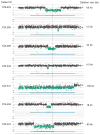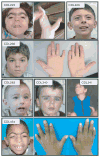NIPBL rearrangements in Cornelia de Lange syndrome: evidence for replicative mechanism and genotype-phenotype correlation
- PMID: 22241092
- PMCID: PMC3556738
- DOI: 10.1038/gim.2011.13
NIPBL rearrangements in Cornelia de Lange syndrome: evidence for replicative mechanism and genotype-phenotype correlation
Abstract
Purpose: Cornelia de Lange syndrome (CdLS) is a multisystem congenital anomaly disorder characterized by mental retardation, limb abnormalities, distinctive facial features, and hirsutism. Mutations in three genes involved in sister chromatid cohesion, NIPBL, SMC1A, and SMC3, account for ~55% of CdLS cases. The molecular etiology of a significant fraction of CdLS cases remains unknown. We hypothesized that large genomic rearrangements of cohesin complex subunit genes may play a role in the molecular etiology of this disorder.
Methods: Custom high-resolution oligonucleotide array comparative genomic hybridization analyses interrogating candidate cohesin genes and breakpoint junction sequencing of identified genomic variants were performed.
Results: Of the 162 patients with CdLS, for whom mutations in known CdLS genes were previously negative by sequencing, deletions containing NIPBL exons were observed in 7 subjects (~5%). Breakpoint sequences in five patients implicated microhomology-mediated replicative mechanisms-such as serial replication slippage and fork stalling and template switching/microhomology-mediated break-induced replication-as a potential predominant contributor to these copy number variations. Most deletions are predicted to result in haploinsufficiency due to heterozygous loss-of-function mutations; such mutations may result in a more severe CdLS phenotype.
Conclusion: Our findings suggest a potential clinical utility to testing for copy number variations involving NIPBL when clinically diagnosed CdLS cases are mutation-negative by DNA-sequencing studies.
Figures




References
-
- Jackson L, Kline AD, Barr MA, Koch S. de Lange syndrome: a clinical review of 310 individuals. Am J Med Genet. 1993;47:940–946. - PubMed
-
- Kline AD, Barr M, Jackson LG. Growth manifestations in the Brachmann-de Lange syndrome. Am J Med Genet. 1993;47:1042–1049. - PubMed
-
- de Lange C. Sur un type nouveau de degeneration (typus Amstelodamensis) Arch Med Enfants. 1933;36:713–719.
Publication types
MeSH terms
Substances
Grants and funding
LinkOut - more resources
Full Text Sources
Medical
Research Materials
Miscellaneous

